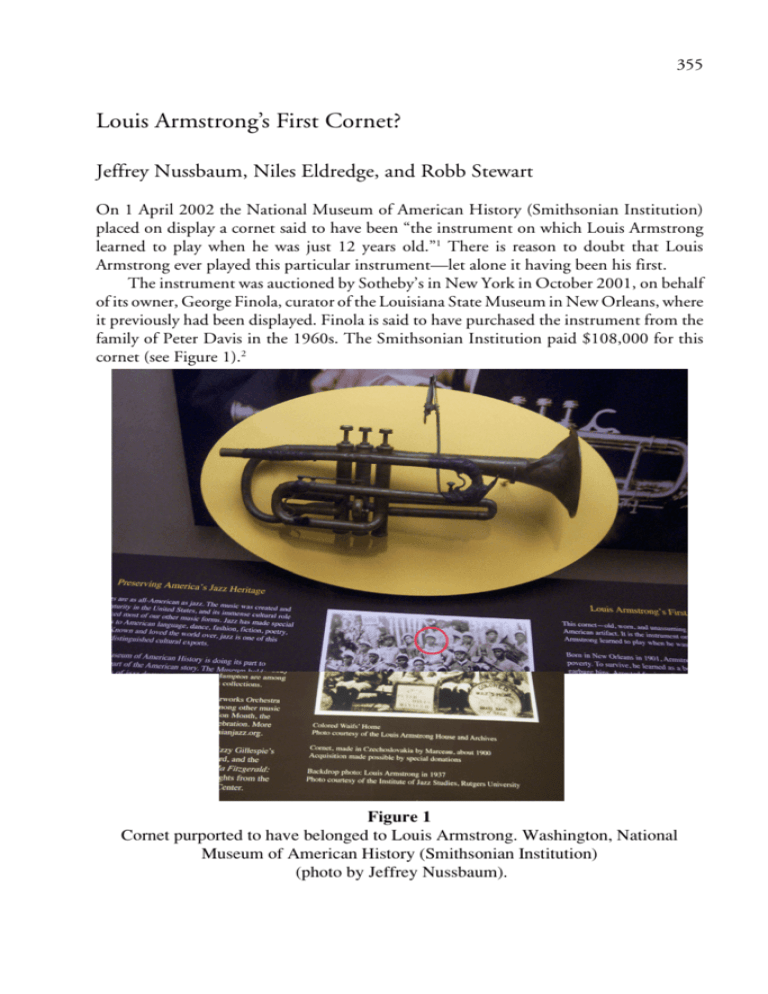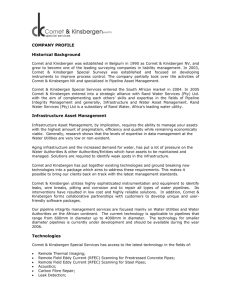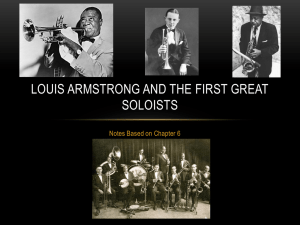Louis Armstrong's First Cornet?
advertisement

355 Louis Armstrong’s First Cornet? Jeffrey Nussbaum, Niles Eldredge, and Robb Stewart On 1 April 2002 the National Museum of American History (Smithsonian Institution) placed on display a cornet said to have been “the instrument on which Louis Armstrong learned to play when he was just 12 years old.”1 There is reason to doubt that Louis Armstrong ever played this particular instrument—let alone it having been his first. The instrument was auctioned by Sotheby’s in New York in October 2001, on behalf of its owner, George Finola, curator of the Louisiana State Museum in New Orleans, where it previously had been displayed. Finola is said to have purchased the instrument from the family of Peter Davis in the 1960s. The Smithsonian Institution paid $108,000 for this cornet (see Figure 1).2 Figure 1 Cornet purported to have belonged to Louis Armstrong. Washington, National Museum of American History (Smithsonian Institution) (photo by Jeffrey Nussbaum). 356 HISTORIC BRASS SOCIETY JOURNAL According to biographer Gary Giddins,3 Armstrong himself claimed that he bought his first cornet at age eleven for $5, using money borrowed from his employers, the Karmofsky family. “People thought that my first cornet was given to me at the Colored Waif’s Home for Boys (the orphanage). But it wasn’t.” Giddins goes on to say that Armstrong’s story of his first cornet confirms accounts given by his contemporaries Bunk Johnson and Sidney Bechet. Whatever the truth of this story, there is no doubt that Armstrong received training on both the bugle and cornet while in the Colored Waif’s Home in New Orleans—to which he was remanded after being arrested for discharging a pistol on 1 January 1913. It was some time after he entered the Waifs’ Home that he was given a bugle to play, and shortly afterwards a cornet, which he learned under the tutelage of Peter Davis. Both the bugle and a distinctly different cornet said to have been these instruments have long been on display at the Louisiana State Museum, to which they were given by Peter Davis himself (see Figure 2).4 Figure 2 Louis Armstrong’s “other” first cornet. New Orleans, Louisiana State Museum (photo used by permission). Given Armstrong’s celebrated status in American music, the enormous price that the instrument fetched is understandable. Our doubts as to its authenticity are based on the specifics of the instrument’s design (a fixed leadpipe “reverse-S” long-bell model) coupled with the sole marking on the instrument: the name Marceau engraved on the bell. Marceau was a trade name employed by Sears Roebuck & Co. for their cheapest-level brass band instrument series, which were imported from Europe.5 Sears, Roebuck & Co. became a leading force in retail sales, in large part due to the success of their mail-order catalogs. Their earliest catalogs, the first of which appeared in 1888, contained only watches and jewelry, but soon afterwards featured a multitude of merchandise, including musical instruments. NUSSBAUM et al. 357 We have examined the entire range of Sears catalogs from their inception through 1927.6 The 1899 catalog advertised the “Celebrated Marceau Band Instruments,” with engravings of various brass instruments, including cornets priced from $14.85 to $21.25— the first appearance of the trade name Marceau. There were no Marceau cornets of the type displayed in the Smithsonian as Armstrong’s “first” cornet in the Sears catalog until 1920. The Fall 1920 catalog, number 141, advertises on page 638 a Marceau cornet #12E 705 with the distinctive reverse-S leadpipe, priced at $9.95. It is unquestionably the same instrument as that on display in the Smithsonian. Details, such as the circular brace inside the first tuning slide (deformed on the Smithsonian instrument) and the “quick-change-to-A” stoprod on top of the second (main) tuning slide, are identical on the catalog image and the Smithsonian’s “Armstrong” instrument (see Figure 3). Figure 3 Drawing of Marceau reverse-S leadpipe cornet from the Sears, Roebuck and Co. Catalogue, Fall, 1920. Although reverse-S leadpipe cornets had been made sporadically since the 1840s and fixed leadpipe reverse-S cornets became common in the first decade of the twentieth century in the United States, none were marketed by Sears under the Marceau name until 1920.7 Marceau was a trade name, not a known maker; American importing firms (Sears, but also J.W. Pepper of Philadelphia, Lyon and Healy of Chicago, etc.) commonly imported “stencil” instruments from Europe—especially from France and the Graslitz region of Bohemia, currently a part of the Czech Republic. Most of these instruments bore fabricated “French”-sounding names. There is no record of a Marceau instrument manufacturing company, nor is any other retail outlet known to have sold Marceau instruments. Thus it seems impossible that Louis Armstrong—whose professional career was well underway by late 1918/early 19198—could ever have played the instrument on display at the Smithsonian Institution’s National Museum of American History. Jeffrey Nussbaum is President of the Historic Brass Society. Niles Eldredge is Curator, Division of Paleontology, the American Museum of Natural History. Robb Stewart is proprietor of Robb Stewart Brass Instruments, Arcadia, California 358 HISTORIC BRASS SOCIETY JOURNAL NOTES 1 See the article at http://www.satchmo.com/louisarmstrong/satchmonews.htmlS. The quotation is from the label accompanying the cornet on display. 2 Ibid. and http://www.shareholder.com/bid/news/20010803-53196.cfm 3 Gary Giddins, Satchmo (New York: Anchor Books, Doubleday, 1988), 64. 4 The New Grove Dictionary of Music and Musicians, ed. Stanley Sadie and John Tyrrell (London: Macmillan, 2001), s.v.“Louis Armstrong,” by James Dapogny. See Giddins, Satchmo, 171, for photographs of these two instruments. A photograph of Joseph Jones, the superintendent and another mentor from the Waifs’ Home, is in Louis Armstrong, Satchmo: My Life in New Orleans (New York: Da Capo Press, 1986), 66, with the caption, “Joseph Jones, who taught Louis Armstrong to play a bugle, holding an instrument on which Louis learned.” The same instrument is depicted in a photograph of Jones’ widow, presenting Louis’ “first cornet” to the Louisiana State Museum, New Orleans, in Jim Matthews, ed., Satchmo: Collector’s Copy (Hollywood, CA: Mateo Publishing Co., 1971), 62. 5 See William Waterhouse, The New Langwill Index: A Dictionary of Musical Wind-Instrument Makers and Inventors (London: Tony Bingham, 1993), 252. Though this entry says Marceau was the name used for the “mid-level” brass instruments from Sears, these were generally the least expensive instruments on sale. 6 Sears, Roebuck & Company Catalog 1888-1927. Microfilm housed in the Science and Business branch of the New York Public Library (*ZAN-V35). 7 Conn and Buescher appear to have been the first companies to produce cornets of this design in the early years of the twentieth century in the United States. See Niles Eldredge, “A Brief History of Pistonvalved Cornets,” Historic Brass Society Journal 14 (2002): 337-90. Sears marketed reverse-S leadpipe cornets prior to 1920, but under the trade name Dupont, not Marceau. 8 According to Giddins (Satchmo, 48), Armstrong was a full-time professional musician beginning in late 1918 or early 1919, playing in Fate Marable’s orchestra on a Mississippi River steamboat. While this note was in press, it came to our attention that a Marceau cornet identical to the Smithsonian instrument was first offered for sale in The Sears, Roebuck Fall 1915 catalogue # 131 (p. 902) as the “American Model.” Preceding catalogues 116 (Spring, 1907) through 130 (Spring, 1915) reveal that a cornet with a reversed-S leadpipe of otherwise radically different configuration to the Smithsonian instrument was sold under the Marceau name beginning in the Fall of 1913 (catalogue 127). According to many sources, Louis Armstrong left the Colored Waif’s home in mid1914--specifically on June 16, 1914, fide Laurence Bergreen’s Louis Armstrong. An Extravagant Life (Broadway Books, 1997, p. 80). Armstrong could not have played the Smithsonian cornet while he was in the Colored Waif’s home.








